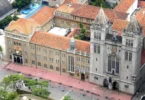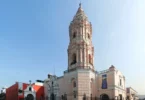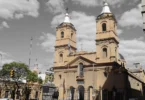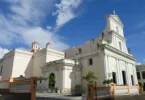Introduction
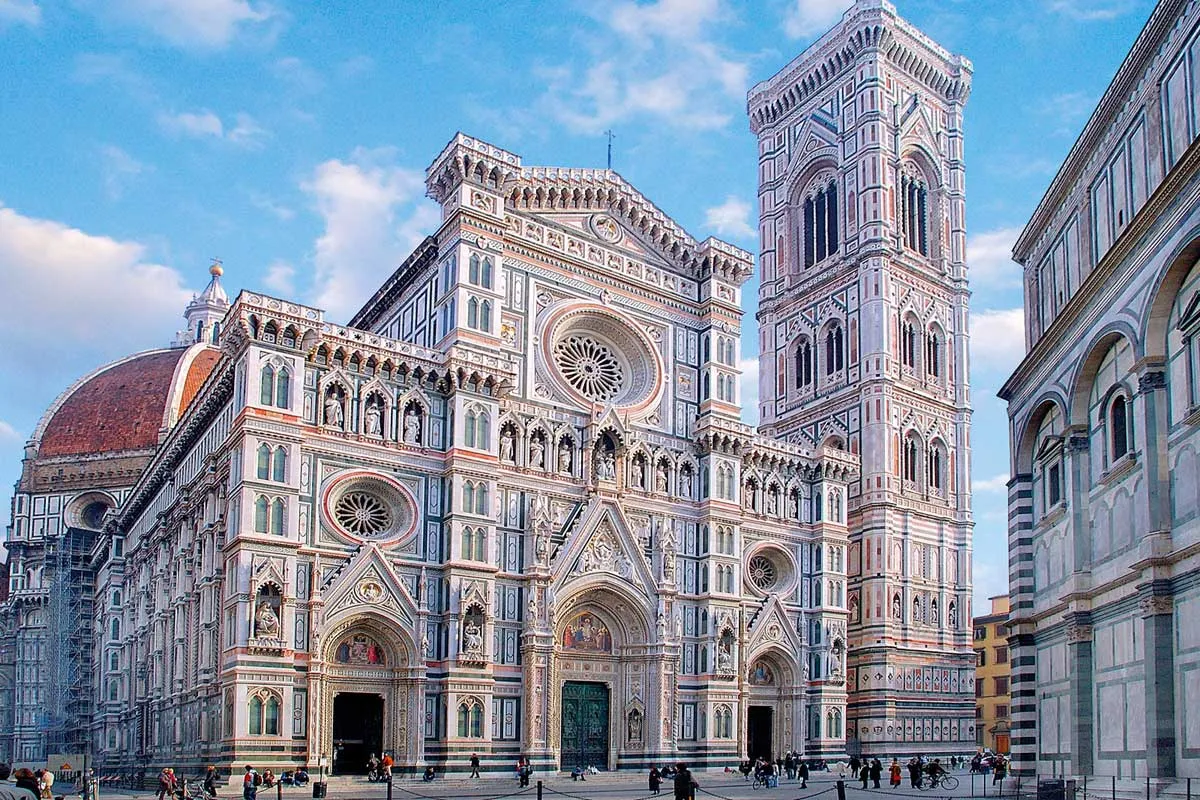
The Florence Cathedral (Italian: Duomo di Firenze), officially known as the Cathedral of Saint Mary of the Flower (Cattedrale di Santa Maria del Fiore), serves as the cathedral of the Catholic Archdiocese of Florence. Construction began in 1296 under the design of Arnolfo di Cambio in the Gothic style, and was completed structurally by 1436 with the iconic dome engineered by Filippo Brunelleschi. The cathedral’s exterior is decorated with polychrome marble panels in shades of green and pink, bordered by white, while the grand Gothic Revival façade (completed in the 19th century) was designed by Emilio De Fabris.
Located in Piazza del Duomo, the cathedral complex includes the Baptistery and Giotto’s Campanile, all of which are part of a UNESCO World Heritage Site that encompasses the historic center of Florence. These buildings are major attractions in Tuscany, with the cathedral itself being one of the largest churches in the world. The cathedral’s dome, the largest masonry dome ever built, remains a remarkable architectural feat. The cathedral is the mother church of the Archdiocese of Florence, symbolizing the city and holding immense historical and cultural significance.
The Florence Cathedral stands on the site of the ancient Santa Reparata church, and its construction has been a significant religious and architectural milestone in Florence, a city that has hosted places of worship since Roman times. When completed in the 15th century, it was the largest church in the world, and it retains the distinction of having the largest masonry dome. The cathedral is dedicated to Santa Maria del Fiore, with its dedication occurring in 1412, although its structural completion came later in 1436 under Pope Eugene IV.
The cathedral’s layout consists of a basilica body with three naves leading into an enormous triconch rotunda, which supports Brunelleschi’s massive dome. The interior boasts the world’s largest frescoed surface, covering 3,600 m², painted between 1572 and 1579 by Giorgio Vasari and Federico Zuccari. The panoramic terrace, located at the base of the dome’s lantern, offers breathtaking views of Florence, situated 91 meters above the city. The neo-Gothic façade, completed in 1887, is a modern addition that exemplifies Italy’s Gothic Revival style. As the cathedral of the Archdiocese of Florence, the cathedral has the capacity to hold up to 30,000 people and is a minor basilica and an Italian national monument, continuing to be a symbol of Florence’s rich history and cultural heritage.

Santa Maria del Fiore, Florence’s grand cathedral, stands on the site of the city’s second cathedral, dedicated to Saint Reparata. The first cathedral, the Basilica di San Lorenzo, was consecrated as a church in 393 by St. Ambrose of Milan. Built in the early 5th century, the structure was subjected to multiple repairs over the centuries, but by the 14th century, it had become dilapidated and was no longer sufficient for the growing population of Florence. In his Nuova Cronica, Giovanni Villani described the cathedral as “crumbling with age.” As other Tuscan cities like Pisa and Siena embarked on ambitious reconstructions of their cathedrals during the Late Medieval period, Florence followed suit with plans for a new, larger cathedral.
The Building of Santa Maria del Fiore
In 1294, the city council approved a new design for the cathedral by architect Arnolfo di Cambio, who was also responsible for the church of Santa Croce and the Palazzo Vecchio. His design featured three wide naves, culminating in an octagonal dome, and was set to encompass the area previously occupied by Santa Reparata. The first stone was laid on 9 September 1296 by Cardinal Valeriano, the first papal legate ever sent to Florence. The construction of the church, a monumental project, would span over 140 years.
Upon Arnolfo’s death in 1302, progress on the cathedral slowed considerably. However, in 1330, the discovery of the relics of Saint Zenobius in Santa Reparata reinvigorated the project. The patronage of the cathedral was taken over by the Arte della Lana, the wool merchant guild, in 1331, and they appointed Giotto as the overseer of the construction in 1334. Giotto, who was also involved in the design of the campanile (bell tower), worked alongside Andrea Pisano. Giotto passed away in 1337, and Pisano continued the work until it was halted due to the Black Death in 1348.
The Completion of the Cathedral
Work on the cathedral resumed in 1349 under several architects, including Francesco Talenti, who enlarged the project to include the apse and side chapels. The nave was finished by 1380, and only the dome remained incomplete. The construction of the dome would prove to be one of the most challenging aspects of the project.
The Dome: A Major Challenge
In 1418, the Arte della Lana announced a competition for the design of the dome. The two main competitors were Lorenzo Ghiberti and Filippo Brunelleschi, both of whom had previously competed for commissions, such as the bronze doors for the Baptistery. While Ghiberti had a successful career, Brunelleschi, supported by Cosimo de’ Medici, ultimately won the commission for the dome. Despite initial setbacks and a brief period when Ghiberti took charge, Brunelleschi took full control of the project by 1423. His groundbreaking design for the dome, which was built without the traditional wooden scaffolding, became an architectural marvel and the first octagonal dome in history.
Construction of the dome began in 1420 and was completed in 1436, just in time for the cathedral’s consecration by Pope Eugene IV on 25 March 1436. During the consecration, the motet Nuper rosarum flores by Guillaume Dufay was performed.
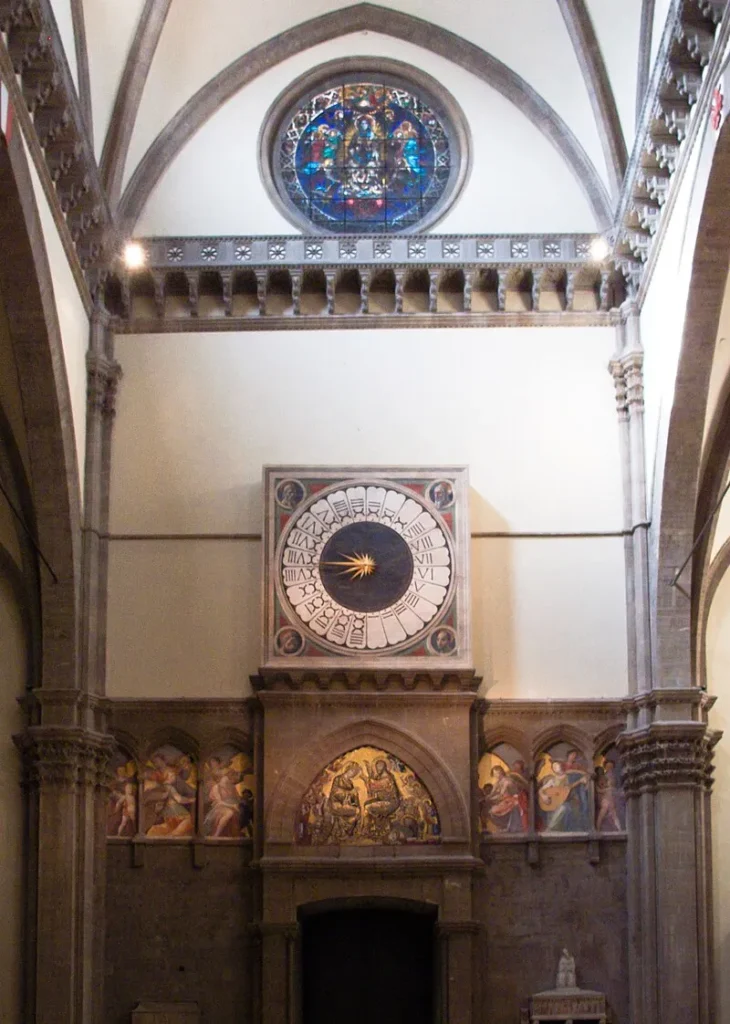
Although initial work on the cathedral’s exterior began in the 14th century, the façade remained unfinished for centuries. Lorenzo de’ Medici initiated a design competition for the façade in the 1490s, but the project ultimately stalled. It was not until 1887 that the façade was completed based on the design of architect Emilio De Fabris, who incorporated polychrome marble in the style of the earlier Baptistery and Giotto’s Bell Tower.
The exterior walls of the cathedral are clad in alternating vertical and horizontal bands of polychrome marble from Carrara, Prato, Siena, and other regions. The intricate decoration of the cathedral’s side doors, including the Doors of the Canonici (south side) and the Door of the Mandorla (north side), features sculptures by renowned artists such as Nanni di Banco, Donatello, and Jacopo della Quercia. The cathedral’s windows are adorned with delicate tracery, with the clerestory windows being round, a common feature in Italian Gothic architecture.
Final Adjustments and Legacy
In the 16th century, the floor of the cathedral was relaid with marble tiles, and over the centuries, other finishing touches were added. Santa Maria del Fiore’s construction, which spanned centuries, culminated in a structure that symbolizes Florence’s power and cultural significance during the Renaissance. Santa Maria del Fiore, or the Florence Cathedral, was built on the site of the earlier Santa Reparata, a church that had grown inadequate as Florence’s population expanded. By the late 13th century, the city had entered a period of remarkable political and cultural growth, prompting the construction of a new cathedral to reflect its prosperity and influence.
The initial plans were entrusted to Arnolfo di Cambio in 1294, with work beginning in 1296. Di Cambio’s design included wide naves and a monumental dome. However, after his death in 1302, construction slowed and was frequently interrupted due to the plague, funding issues, and other challenges. A significant turning point came in 1330, when the discovery of the relics of Saint Zenobius sparked renewed interest in completing the cathedral. Giotto di Bondone was appointed in 1334 to oversee the project, particularly focusing on the bell tower. After Giotto’s death in 1337 and the subsequent loss of other key figures, progress once again stalled.
In the mid-14th century, Francesco Talenti took over the project, making significant changes to the original design, such as expanding the apse and constructing side chapels. The nave was completed by 1380, but the dome remained the major challenge. In 1418, a competition was held to design the dome, with Filippo Brunelleschi emerging victorious. Brunelleschi’s innovative design, completed in 1436, was the largest dome in the world at the time and remains one of the cathedral’s defining features.
The cathedral was consecrated in 1436, and additional work on the façade continued into the 19th century, when it was completed under the guidance of Emilio De Fabris. Today, Santa Maria del Fiore stands as a testament to the city’s historical and cultural significance, drawing millions of visitors each year to admire its beauty and grandeur.
Santa Maria del Fiore’s Historical and Cultural Importance
Beyond its architectural achievements, Santa Maria del Fiore has played a central role in Florence’s history. The cathedral has witnessed numerous important events, including the Council of Florence in the 15th century and the infamous Pazzi Conspiracy of 1478, during which Lorenzo de’ Medici narrowly escaped assassination. The cathedral’s blend of Gothic and Renaissance architecture, along with the engineering marvel of Brunelleschi’s dome, continues to inspire admiration and awe worldwide. It remains an enduring symbol of Florence’s artistic, political, and religious heritage.
Architecture Of Cathedral of Santa Maria del Fiore, Florence, Italy
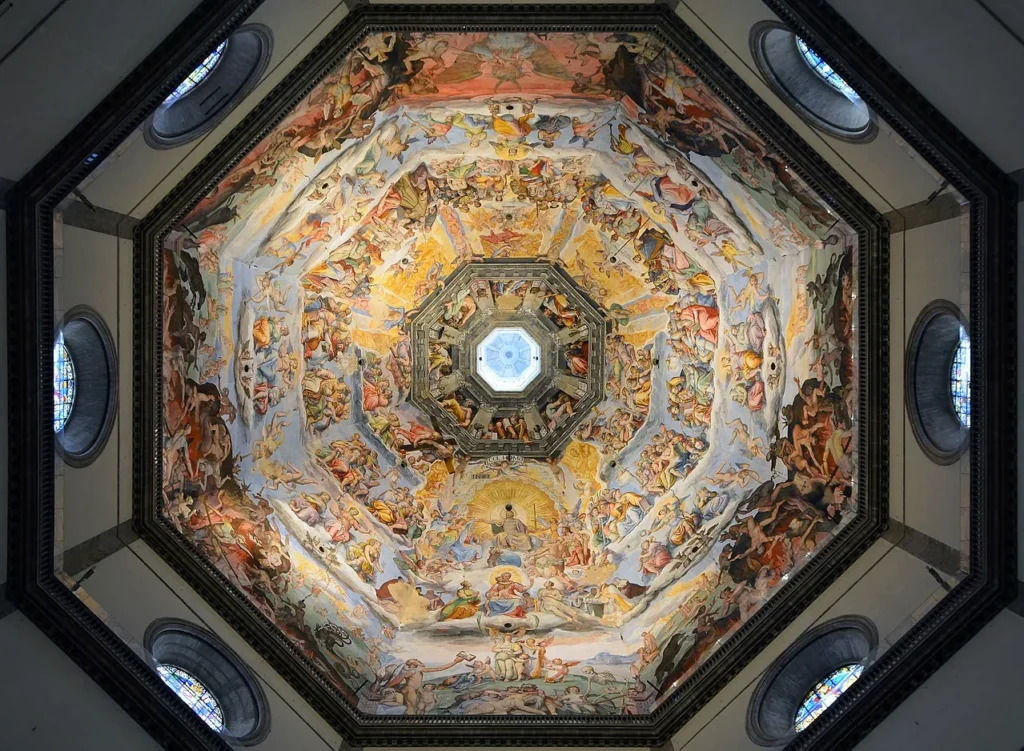
Architects: Filippo Brunelleschi , Arnolfo di Cambio , Francesco Talenti , Emilio De Fabris.
Architectural Styles: Renaissance architecture , Gothic architecture.
Exterior, Plan, and Structure of Florence Cathedral
The exterior, plan, and structure of the Florence Cathedral (Santa Maria del Fiore) illustrate its grandeur, complexity, and the evolution of architectural and artistic traditions over the centuries.
Plan of the Church and Its Extensions
The cathedral is designed as a basilica, consisting of a wide central nave with four square bays, flanked by aisles on both sides. The chancel and transepts are polygonal in shape, and they are separated by two smaller polygonal chapels, forming the Latin cross layout. The nave and aisles are divided by pointed Gothic arches supported by composite piers. The vast dimensions of the cathedral are impressive: the building spans an area of 8,300 m², with a length of 153 meters, a width of 38 meters, and a crossing width of 90 meters. The height of the aisles’ arches reaches 23 meters, and the dome towers at 114.5 meters, making it the fifth tallest dome in the world.
Planned Sculpture for the Exterior
In its early construction phases, the cathedral was envisioned to have large sculptures of Old Testament figures adorning its buttresses. Donatello, at age twenty, was commissioned in 1408 to create a statue of David, which was never placed on the cathedral. Other notable sculptures by Donatello, including representations of Joshua, Saint John the Evangelist, and several figures for the campanile, contributed significantly to the cathedral’s artistic legacy. Michelangelo’s famous statue of David was also planned for the cathedral but was ultimately too large for the intended space. A replica of Michelangelo’s David was installed on the cathedral’s exterior in 2010.
The Dome: A Marvel of Engineering
The dome of the Florence Cathedral is one of the greatest architectural achievements of the Renaissance. The original plan included an octagonal dome, but the absence of external buttresses posed a significant structural challenge. In 1367, Neri di Fioravanti proposed a design without buttresses, which marked a break from Gothic traditions. The dome, constructed under the genius of Filippo Brunelleschi, was completed in 1436. Brunelleschi’s innovative engineering solutions, including the double-shell design, vertical ribs, and herringbone brick pattern, made it the largest masonry dome in the world. The dome’s lantern was completed by Michelozzo, with a gilt copper ball added by Andrea del Verrocchio in 1469, though it was struck by lightning in 1600 and later replaced.
Facade of the Cathedral
The facade of the cathedral underwent various phases of design and construction, starting with Arnolfo di Cambio’s plan and later undergoing partial contributions from Giotto. However, the façade remained unfinished for centuries. In the 16th century, under Francesco I de’ Medici, the earlier façade was dismantled. It wasn’t until the 19th century that a competition was held to complete the façade, won by Emilio De Fabris. The neo-Gothic façade was finished in 1887 and integrates white, green, and red marble, harmonizing with the cathedral, the bell tower, and the Baptistery. The façade features statues of important religious figures, with a central tympanum depicting the Glory of Mary and busts of notable artists.
The Doors and Mosaics
The cathedral features three grand bronze doors installed between 1899 and 1903, designed by Augusto Passaglia and Giuseppe Cassioli. These doors depict scenes from the life of the Madonna, with Passaglia’s central door being the most prominent. The mosaic lunettes above the doors, designed by Nicolò Barabino, illustrate themes of charity, Christ with Mary and Saint John the Baptist, and homage to the Virgin by Florentine artisans. The crowning pediment includes sculptures of the Madonna with Child and the Twelve Apostles, adding to the rich iconography of the cathedral.
Southern Flank of the Cathedral
The southern side of the cathedral is decorated with polychrome marble, sourced from various regions including Campiglia, Carrara, and Siena. The first bays feature ornate windows and sculptural elements, some of which are casts of the original works. Notably, the “Door of the Bell Tower,” with its Christ Blessing relief, is attributed to the circle of Andrea Pisano. Further along, the “Door of the Canons” displays flamboyant Gothic carvings by Lorenzo di Giovanni d’Ambrogio and Piero di Giovanni Tedesco, with a Madonna and Child relief by Niccolò di Pietro Lamberti.
Northern Flank of the Cathedral
The northern flank mirrors the southern in terms of design and decoration. The Porta di Balla (or Porta dei Cornacchini) is a notable feature, dating from around 1350-1360. The door is adorned with twisted columns and stylobate lions, with a Madonna and Child in the lunette. The Porta della Mandorla, near Via dei Servi, features a high relief of the Assumption, attributed to Nanni di Banco, along with intricate reliefs by Giovanni d’Ambrogio, Jacopo di Piero Guidi, and Piero di Giovanni Tedesco.
Apse Area of the Cathedral
The apse area includes the octagonal dome and three apses aligned with the cardinal points. These are prismatic in shape and supported by flying buttresses. The windows, attributed to Lorenzo Ghiberti, add an elegant touch to the design. Above the apse galleries are the “dead galleries,” semicircular spaces designed by Brunelleschi, with a continuous gallery above. Gargoyles in the shape of zoomorphic heads protrude from the structure, adding to the cathedral’s gothic elements.
Originally, Michelangelo’s David was intended for one of the buttresses of the north tribune but was instead placed in Piazza dei Priori for better visibility. Statues were also intended to decorate the apse, emphasizing its significance in the cathedral’s overall design.
Main Portal
The three large bronze doors, created between 1899 and 1903, are decorated with scenes from the life of the Madonna. Above the doors, in the lunettes, are mosaics designed by Niccolò Barabino, depicting (from left to right): Charity among the founders of Florentine philanthropic institutions, Christ enthroned with Mary and John the Baptist, and Florentine artisans, merchants, and humanists. The pediment above the central portal features a half-relief by Tito Sarrocchi, showing Mary enthroned and holding a flowered scepter. The right-hand door was sculpted by Giuseppe Cassioli.
At the top of the façade, a series of niches holds statues of the twelve Apostles, with the Madonna and Child in the center. Above the rose window and tympanum, there is a gallery displaying busts of notable Florentine artists.
Interior of the Florence Cathedral
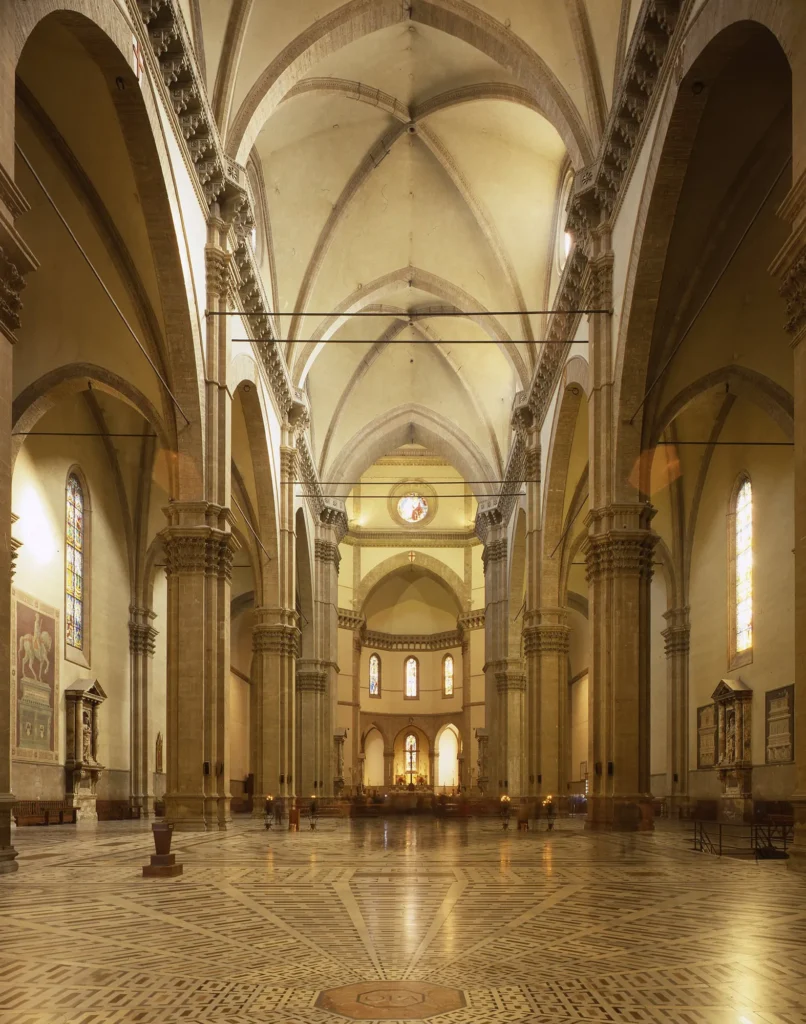
The interior of the Florence Cathedral is vast and evokes a sense of emptiness, reflecting the austere religious life promoted by Girolamo Savonarola. Over time, many decorations have been lost or relocated to the Museum Opera del Duomo, including the magnificent cantorial pulpits (singing galleries for the choristers) designed by Luca della Robbia and Donatello.
The cathedral was built with public funds, and several works of art within the church honor prominent figures and military leaders of Florence:
Lorenzo Ghiberti’s Contributions
Lorenzo Ghiberti had a significant artistic impact on the cathedral. He collaborated with Filippo Brunelleschi on various projects over 18 years, working on numerous aspects of the cathedral’s east end, including stained glass designs, the bronze shrine of Saint Zenobius, and the marble revetments on the cathedral’s exterior.
Notable Artworks and Monuments
- Dante Before the City of Florence (1465) by Domenico di Michelino is a captivating painting that not only depicts scenes from Dante’s Divine Comedy but also shows Florence as it appeared in 1465, a city Dante himself could not have seen.
- Funerary Monument to Sir John Hawkwood (1436) by Paolo Uccello, a monochrome fresco painted in terra verde, was transferred to canvas in the 19th century and is notable for its depiction of the condottiero as a heroic figure.
- Equestrian Statue of Niccolò da Tolentino (1456) by Andrea del Castagno, another fresco transferred to canvas, also portrays a condottiero in a triumphal pose, though with a more dynamic sense of movement.
- Busts of renowned figures such as Giotto (by Benedetto da Maiano), Brunelleschi (by Buggiano – 1447), Marsilio Ficino, and Antonio Squarcialupi (a famous organist) from the 15th and 16th centuries.
- The colossal clock face above the main door, with fresco portraits of the four Prophets or Evangelists by Paolo Uccello (1443), features a one-handed liturgical clock that tracks the hora italica (Italian time), a system used until the 18th century.
Stained Glass Windows and Decoration
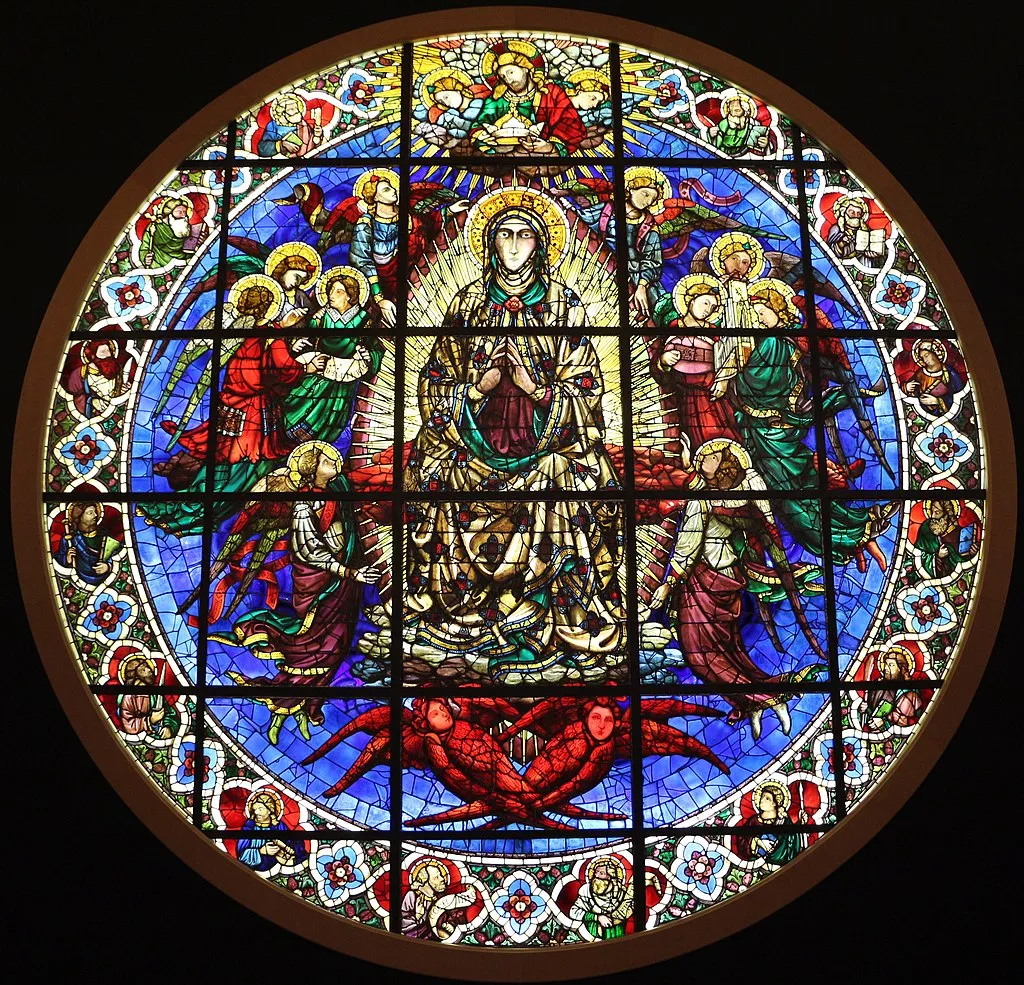
The cathedral houses 44 stained glass windows, the largest collection of its kind in Italy from the 14th and 15th centuries. These windows depict scenes from both the Old and New Testament, with the circular windows in the dome’s drum and above the entrance portraying Christ and Mary. The windows are the work of prominent Florentine artists, including Donatello, Lorenzo Ghiberti, Paolo Uccello, and Andrea del Castagno.
- Christ Crowning Mary as Queen (14th century), designed by Gaddo Gaddi, is one of the key stained glass windows, located above the clock.
- Donatello designed the stained glass window Coronation of the Virgin in the dome’s drum, which is the only window visible from the nave.
Notable Monuments and Sculptures
- Funeral Monument of Antonio d’Orso (1323), by Tino da Camaino, is one of the most significant funeral monuments of its time.
- A monumental crucifix behind the Bishop’s Chair at the high altar, created by Benedetto da Maiano (1495–1497).
- The choir enclosure, designed by Bartolommeo Bandinelli.
- The ten-paneled bronze doors of the sacristy, crafted by Luca della Robbia, along with two glazed terracotta works inside the sacristy: Angel with Candlestick and Resurrection of Christ.
Altars and Shrines
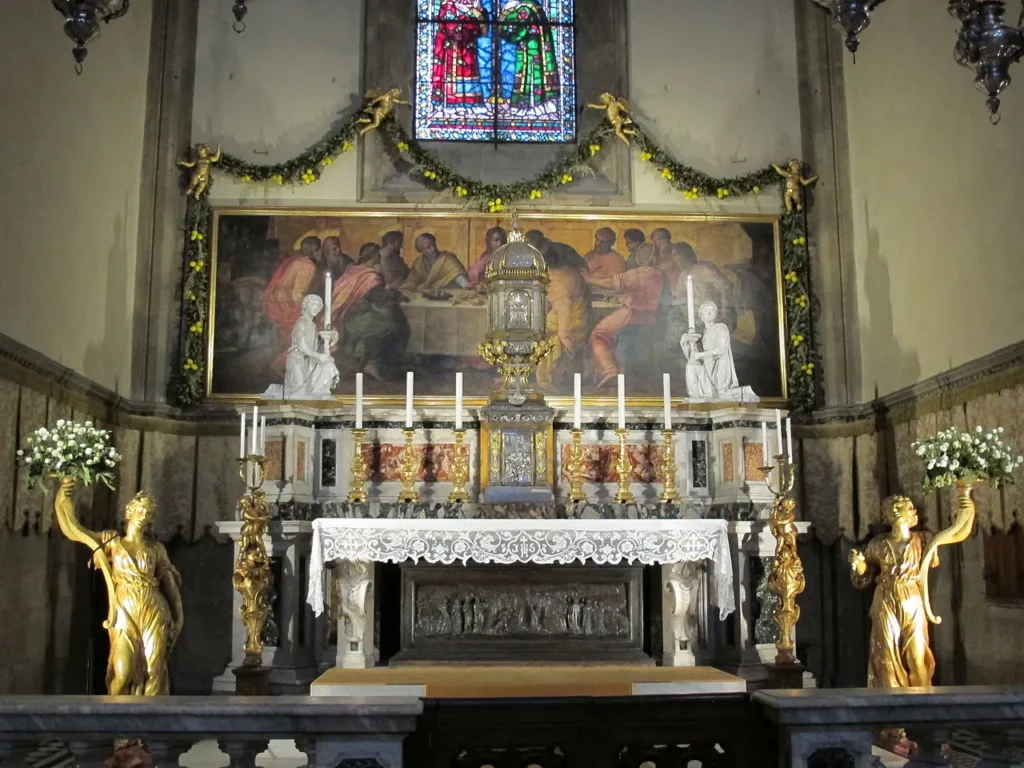
The altar of Saint Zanobius, located in the back of the central apse, holds a silver shrine designed by Ghiberti that contains the relics of Florence’s first bishop. Above the shrine is a painting of the Last Supper by Giovanni Balducci.
Floor and Ceiling Decorations
The 16th-century pavement, designed by Baccio d’Agnolo and Francesco da Sangallo, features colored marble. Following the 1966 flooding, restoration revealed that some marble from the unfinished façade had been repurposed for the floor.
The dome’s ceiling, initially left whitewashed, was painted under the patronage of Grand Duke Cosimo I de’ Medici. Giorgio Vasari began the work in 1572, completing it in 1579. The frescoes, which cover 3,600 m², depict The Last Judgment. These frescoes, created by Vasari and later completed by Federico Zuccari and other artists, are considered Zuccari’s greatest work, though their quality varies due to differing techniques used by the artists. The restoration work of 1995 cataloged and photographed the frescoes, preserving their details.
Counter-Facade
The counter-façade features the Italic clock with portraits of the Evangelists, frescoed by Paolo Uccello (1443). The clock, one of the few surviving examples of hora italica, is still functional. The lunette of the central portal contains the mosaic of The Coronation of the Virgin, attributed to Gaddo Gaddi. On the sides of the portal are angels painted by Santi di Tito, while the tomb of Bishop Antonio d’Orso (1343) by Tino di Camaino stands to the right of the central portal.
Crypt
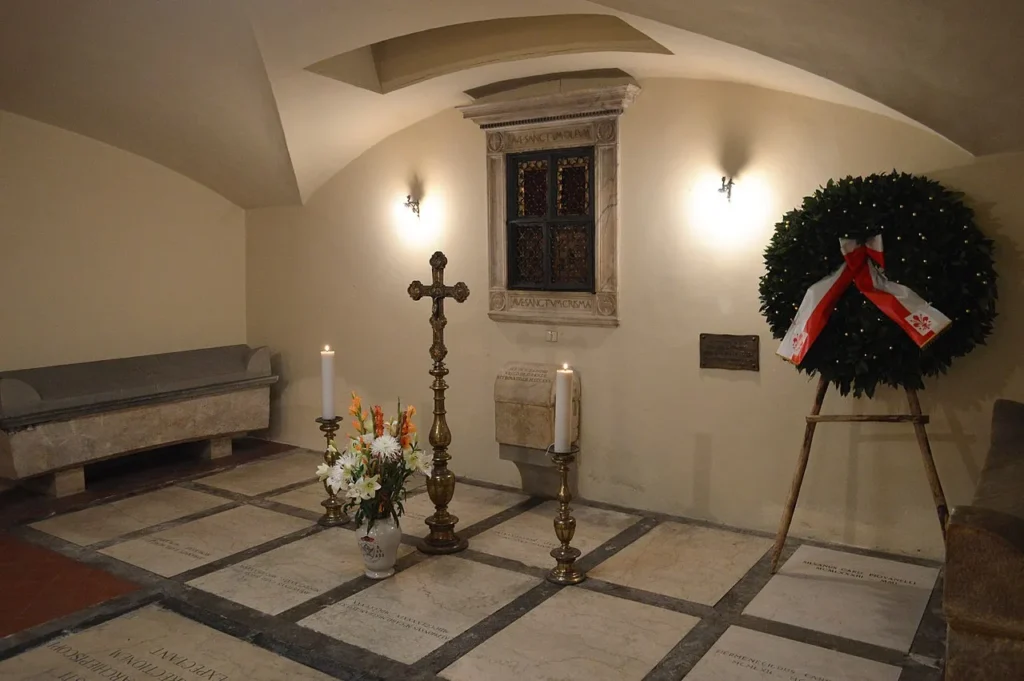
The cathedral underwent extensive excavations between 1965 and 1974, and the archaeological history of this vast area was reconstructed through the work of Franklin Toker. The excavation revealed remains of Roman houses, an early Christian pavement, the ruins of the former cathedral of Santa Reparata, and various enlargements of this church over time. Close to the entrance of the crypt, which is open to the public, lies the tomb of Filippo Brunelleschi. Despite its prominent location, Brunelleschi’s tomb is notably simple and humble. The fact that the renowned architect was given such a prestigious burial place demonstrates the high esteem in which he was held by the Florentines.
Cracking of the Dome
The unreinforced masonry used by Brunelleschi to construct the dome is particularly weak in tension, leading to cracking when tensile stresses exceed the masonry’s limited tensile strength. This material is especially vulnerable to damage from seismic activity due to its heterogeneity and the numerous surfaces where different materials meet (such as stone to mortar). Cracking was observed even before the dome’s construction was completed. The first cracks may have been caused by a strong earthquake in 1453. Written evidence of the cracks first appeared in a 1639 report by Gherardo Silvani, which referred to the cracks as “peli” (“hairs”). In 1694, Giambattista Nelli and Vincenzo Viviani conducted a survey, finding two major cracks, one up to 29 mm (1.1 in) wide. They believed these cracks were caused by the weight of the dome and the horizontal forces exerted on the pillars.
In 1695, a commission led by Vincenzo Viviani recommended that the dome be reinforced with iron belts, similar to a solution used on the dome of St. Peter’s in Rome. However, after much debate, it was decided to leave the dome as it was. A more complete survey of the cracks was published in 1757 by the Jesuit Leonardo Ximenes, who identified 13 types of cracks. In 1934, Pier Luigi Nervi, leading a special commission set up by the Opera del Duomo, found that the cracks expanded and contracted seasonally. In winter, the dome’s materials contracted, widening the cracks, while in summer they expanded, causing the cracks to close. This natural movement, in the absence of modern expansion joints, allowed the structure to “breathe” without causing catastrophic damage.
From 1955 to 2009, 22 mechanical deformometers were installed to measure the variation in the width of major cracks. In 1975, the Italian government set up a commission to safeguard the dome. By 1978, work began on restoring the frescoes inside the dome, during which Brunelleschi’s scaffolding holes were filled with concrete to support the modern scaffolding required for the restoration. However, this led to new cracks forming around the sealed holes, as the energy from the expansion and contraction of the dome was now redirected to other parts of the structure.
Naves
The cathedral contains several works reflecting its public function, including monuments dedicated to prominent Florentines and military commanders. In the 15th century, Florence’s chancellor Coluccio Salutati envisioned the cathedral as a Pantheon for illustrious Florentines, and a number of artistic works were created in line with this vision. Among these are:
- Dante with the Divine Comedy by Domenico di Michelino (1465), which features a city view with the dome still unfinished and a depiction of the city gates before certain demolitions.
- Equestrian Monuments of John Hawkwood (by Paolo Uccello, 1436) and Niccolò da Tolentino (by Andrea del Castagno, 1456), which are both heroic, triumphant depictions of military figures.
- Busts of Illustrious Figures: These include busts of Emilio de Fabris, Antonio Squarcialupi, Arnolfo di Cambio, Giotto, Brunelleschi, and Marsilio Ficino.
The cathedral also features stained glass windows, statues of prophets and saints, and several painted panels dedicated to various religious figures.
Choir
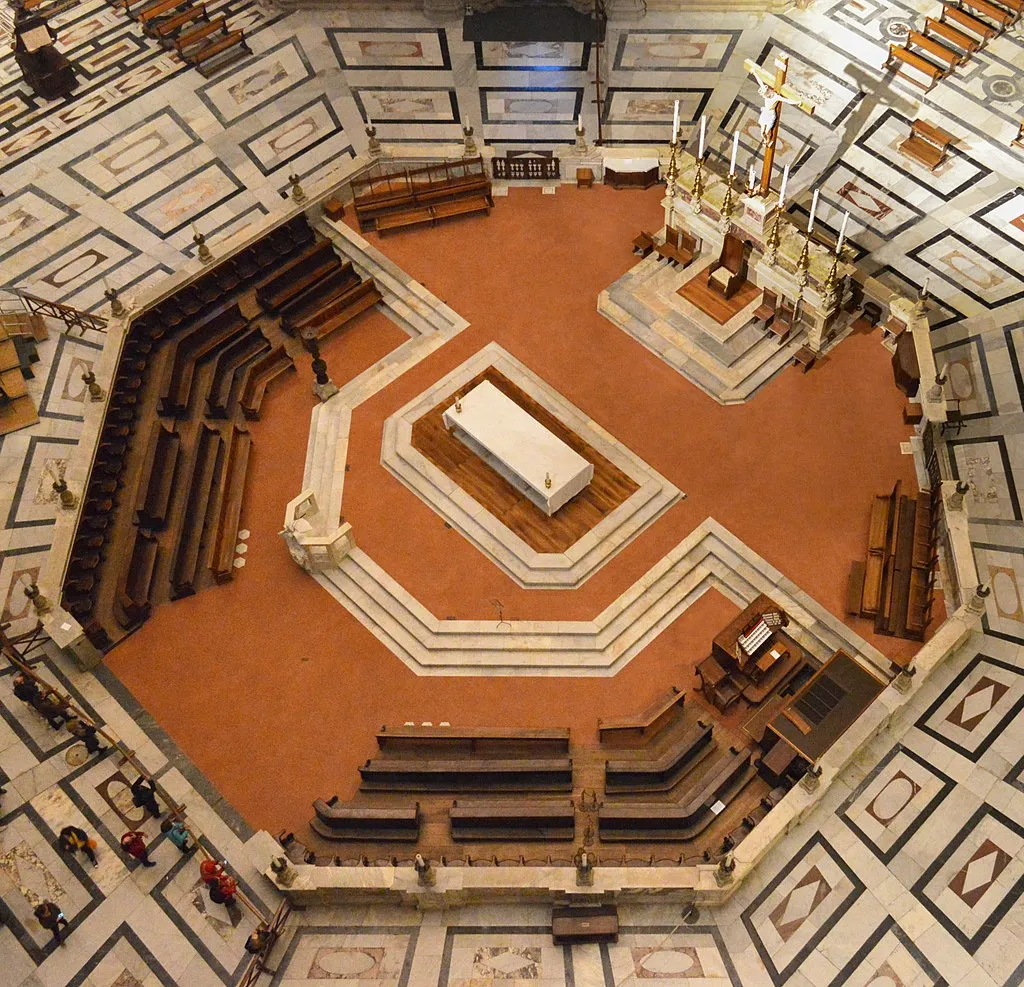
The space beneath the dome, designed as an octagon, leads into three galleries, with two sacristies. The neo-Gothic arches above the sacristy doors were added in 1842 by Gaetano Baccani to house organs and choir stalls. The choir itself was built between 1547 and 1572 by Baccio Bandinelli and Giuliano di Baccio d’Agnolo to replace an earlier choir created by Nanni Unghero and others. Within the choir, there are 16th-century wooden stalls and a raised presbytery housing the high altar. The pulpit, created in the 15th century, is flanked by a polychrome wooden crucifix. The choir underwent several modifications over the centuries, and the most recent additions were completed in the mid-19th century.
Tribunes
Each gallery in the cathedral has five chapels arranged radially, most of which feature 15th-century stained glass windows attributed to Ghiberti. The central tribune, named San Zanobi, contains the chapel housing the relics of Saint Zanobi, with a bronze ark designed by Lorenzo Ghiberti in 1442. This chapel also includes a Last Supper by Giovanni Balducci and mosaic decorations. The right tribune, Santissima Concezione, contains a significant central chapel with an altar designed by Michelozzo. The left tribune, Holy Cross, contains a solar gnomon designed by Paolo dal Pozzo Toscanelli and updated by Leonardo Ximenes in 1755.
Sacristies
There are two sacristies in the cathedral, each with distinct decorative features. The Canons’ Sacristy houses a washbasin created by Buggiano and Pagno di Lapo, along with several paintings depicting religious figures. The Masses Sacristy, also known as the Sacristy of the Servi, features wooden inlays by Alesso Baldovinetti and others, representing scenes from the Old Testament and the life of Saint Zanobi. The doors of the sacristy are adorned with bronze panels created by Luca della Robbia, depicting biblical figures.
The Interior Decoration of the Dome
Initially, the dome of the cathedral was intended to be adorned with golden mosaics to maximize the reflection of light from the drum’s windows, as per Filippo Brunelleschi’s original vision. However, following his death, this costly project was set aside, and the interior was simply plastered white.
Grand Duke Cosimo I de’ Medici later chose the theme of the Last Judgement for the fresco decoration of the vast dome and entrusted the task to Giorgio Vasari. Assisted by Don Vincenzo Borghini, Vasari followed the iconographic guidelines set out by the Council of Trent, which sought to clarify and systematize Catholic doctrine. The dome was divided into six registers and eight segments, with each segment containing four scenes:
- An angelic choir with Passion instruments (second register)
- A category of saints and elect (third register)
- A triad of personifications, representing gifts of the Holy Spirit, virtues, and beatitudes
- A region of Hell, dominated by a deadly sin
The eastern segment, facing the central nave, was given special treatment, reducing the four registers to three in order to accommodate a large depiction of Christ in Glory between the Madonna and Saint John, surrounded by the three Theological Virtues: Faith, Hope, and Charity. Below this, allegorical figures of Time, with a character holding an hourglass and two children representing nature and the seasons, along with the triumphant Church, were depicted.
Vasari passed away on June 27, 1574, having only completed one-third of the work, including the circle of the Twenty-four Elders of the Apocalypse nearest the lantern. The frescoes, which were begun in 1572 and completed by 1579, were then continued by Federico Zuccari and his collaborators, including Domenico Cresti. Zuccari’s work included majestic depictions of Christ and Satan, along with the Choir of Angels, saints, virtues, and gifts of the Holy Spirit. His fresco style was quite different from Vasari’s, as he abandoned the traditional fresco technique for a dry method, which was simpler but more perishable. This transition also resulted in a change of physical types, costumes, and stylistic language. In The Elect, Zuccari depicted a lively gallery of contemporary figures, including Medici patrons, artists like Vasari and Giambologna, and even his own relatives and friends.
The frescoes in the dome were painted with the view from below in mind, utilizing perspective and color distortions that are visible only from a distance. The technique employed was mixed: Vasari used traditional fresco, while Zuccari applied dry techniques.
Pipe Organs
The cathedral houses a remarkable pipe organ, the Mascioni Organ Opus 805, which was built starting in 1961 and expanded several times. It now features 7,551 pipes across 128 registers and is operated with electronic transmission.
The organ is divided into several bodies within the church:
- The open mobile Positive (first manual), located on the left side of the octagon.
- The open choral Positivo (first manual), situated inside the presbytery enclosure on the right, with no display.
- The Grand Organ (second manual), positioned in the left gallery.
- The Espressivo (third manual), located in the right gallery.
- The Chapel Organ (fourth manual), from the Chapel of San Jacopo Maggiore in the left tribune, consisting of two sections: one open and one expressive.
- The Echo (fifth manual), derived from the organ in the Chapel of San Matteo in the right gallery, also consisting of two sections: one open and one expressive.
- The Pedal, distributed among the various organ bodies.
The organ has four independent and mobile consoles, allowing for control of all the bodies. One five-manual console is located outside the choir, another four-manual console near the open choral Positivo body, a three-manual console in the Chapel of San Jacopo Maggiore, and a two-manual console in the Chapel of Santi Simone e Giuda.
Additionally, the cathedral houses a Positive Chest Organ built by Nicola Puccini in 2012, which has five registers. The current titular organists of the cathedral are Daniele Dori and David Jackson.
Feast Day
Feast Day: 08 September.
The feast day of the Florence Cathedral (Santa Maria del Fiore) is celebrated on 8th September, which is the Feast of the Nativity of the Virgin Mary. This date is significant as it marks the dedication of the cathedral to the Virgin Mary, and it also coincides with the foundation of the cathedral, which was begun on this date in 1296.
Church Mass Timing
Saturday : 10:15 PM
Sunday : 10:15 PM
Church Opening Time:
Monday : 10:15 am – 3:45 pm
Tuesday : 10:15 am – 3:45 pm
Wednesday : 10:15 am – 3:45 pm
Thursday : 10:15 am – 3:45 pm
Friday : 10:15 am – 3:45 pm
Saturday : 10:15 am – 3:45 pm
Sunday : Closed
Contact Info
Address :
Piazza del Duomo, 50122 Florence FI, Italy
Phone : +39 055 230 2885
Accommodations
Connectivities
Airway
Amerigo Vespucci Airport to Cathedral of Santa Maria del Fiore, Florence, Italy distance between 30 min (10.8 km) via SS67.
Railway
Santa Maria Novella Firenze to Cathedral of Santa Maria del Fiore, Florence, Italy distance between 3 min (500.0 m) via Via de’ Cerretani and Via Panzani.


